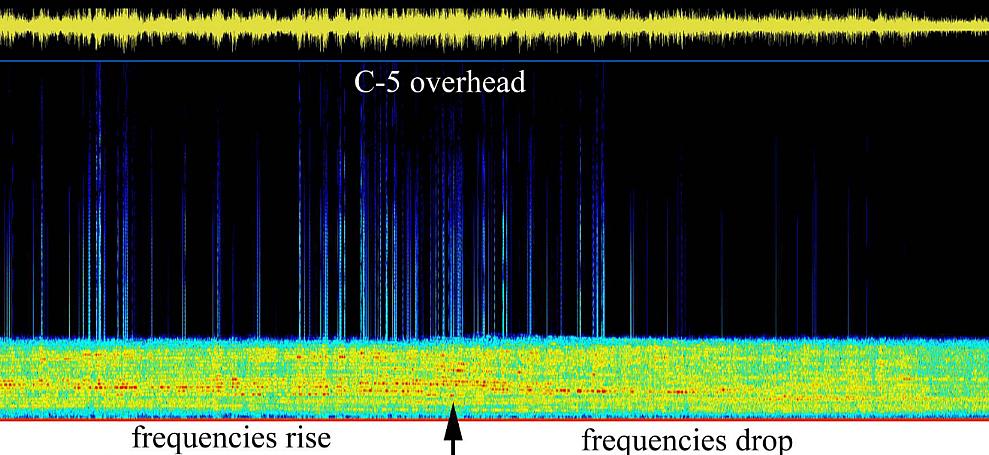Reversed Doppler
Raw WAV files
download 1
706 kb
28Apr1993
spectrogram
download 2
6.437 Mb
10Aug1996
spectrogram
Noise (caused by moving mic) marks the midpoint when craft overhead.
download 3
1.921 Mb
22Jan1997
spectrogram total frequencies
spectrogram lower frequencies
Stereo: Note the dogs yapping after the noise abates.
Normal Doppler
On 7 November 2007 Bruce Cornet was at Stewart International
Airport (also Stewart Air Force Base) when a C-5 transport plane took off and circled
around the airport before disappearing. He recognized the sound as similar to that
made by the Manta Ray craft on 10 August 1996 and on 22 January 1997, calling it a weird
sound.(http://www.sunstar-solutions.com/AOP/Weirdsound/weirdsound.htm).
The C-5 makes this type of sound only when taking off - possibly a result of all four
engines at maximum throttle. As the C-5 came towards him, it displayed a normal
Doppler sound: Frequencies rose until the plane was overhead, then the frequencies dropped
as the C-5 moved away. He recorded the plane and sound as an MOV file on his
camera. A laterally-time-compressed frequency spectrogram below shows a normal
Doppler. You can download the sound file to hear it and compare it to the reversed
Doppler. Because this sound is only produced when a C-5 accelerates during take-off,
for the Manta Ray to be confused with a C-5 taking off would mean that such an enormous
aircraft had taken off from a nearby farm field nine miles from the airport - an
impossibility. Therefore, was the Manta Ray trying to mimic a C-5? Its
navigation light also mimicked those of a C-5. See "Mimicry
may be the Objective of ETI Triangular and Diamond-shaped Probes" (http://www.sunstar-solutions.com/AOP//Litebeams/main1.htm).

download C-5 sound
1.537 Mb
7 November 2007
download C-5 video
31.893 Mb
PB070011.MOV
Frequency Spectrograms
28Apr1993 (voice of Ellen
Crystall recorded)


Note midpoint where banded frequencies begin to rise in pitch after
Flying Triangle passes over camcorder, which is typical of all the UAP recorded. Also note
how frequences become more bunched at lowest point, possibly reflecting a vertical
compression component underneath the craft.

10Aug1996 (no voice recordings)

Sound begins when craft about 1/2 mile away; note how pitch first rises
until 5 sec, then levels out and begins descending in frequency, indicating that the
reversed Doppler effect only stretches out so far from the craft.


midpoint 39-40 seconds

Frequency bands begin to level out at 55 sec as reversed Doppler offsets
normal Doppler.

22Jan1997 (no voice recording;
dogs yapping at end)
Total range (0 - 10 kHz)

Note how higher band of frequencies between 6 kHz and 7 kHz rise in pitch
according to a delayed normal Doppler effect, because the mid point (36 sec) or transition
to lower frequencies occurs well after craft past mic (29 sec), indicating a possible
reflection of these higher frequencies off of a phase transition boundary behind the
craft. The higher frequencies may represent harmonics of the lower frequencies, or
possibly even turbine sounds generated by the engines.
Magnified lower frequencies (0
- 1300 Hz)



36 sec represents the time or point when the frequency bands stop being compressed
together or more tightly bunched, and begin a slow recovery or return to more separation
after the craft passed the mic.

Dogs yapping.






